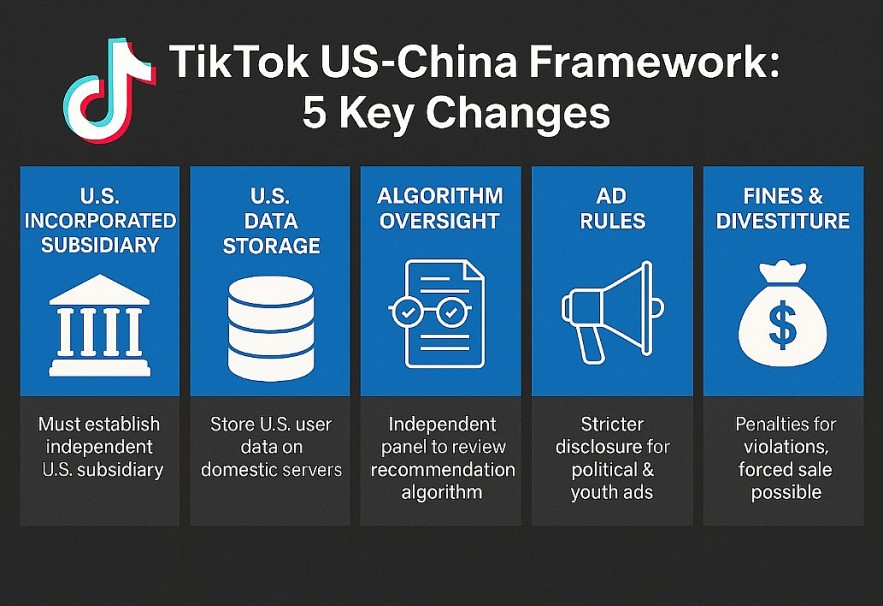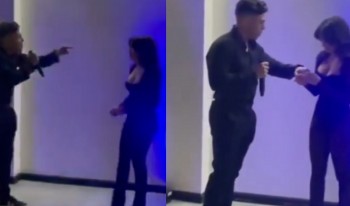TikTok Stays—for Now: Inside the US–China Framework Agreement and Its Impact on Creators, Advertisers & Users
On the night of September 15, 2025, the White House announced a framework agreement with TikTok’s Chinese parent company to avoid a looming ban. The deal represents one of the most significant regulatory compromises between Washington and Beijing over a tech platform, setting new rules for data storage, algorithm oversight, and advertising practices in the United States.
With over 150 million US users, TikTok has been at the center of a multi-year standoff over national security, data privacy, and foreign influence. This new agreement—while far from a final settlement—offers a path forward that stabilizes the platform but imposes unprecedented oversight.
Read more: The Fate of TikTok in the U.S.: A New Deal Ahead of the September 17 Deadline
 |
| What the Framework Agreement Covers |
What the Framework Agreement Covers
| Key Area | Major Changes Announced September 15, 2025 |
|---|---|
| Ownership & Structure | ByteDance retains majority ownership but must establish a US-incorporated subsidiary with an independent board and compliance officers approved by the US government. |
| Data Privacy | All US user data will be stored on domestic servers operated by a US-based cloud provider. Third-party audits will be mandatory. |
| Algorithm Oversight | An independent panel appointed by the Federal Trade Commission (FTC) will review TikTok’s recommendation algorithm quarterly for content manipulation or bias. |
| Advertising Transparency | Stricter disclosure rules on political advertising, youth-targeted ads, and influencer sponsorships. |
| Penalties for Violations | Fines up to $10 million per violation and potential forced divestiture if national-security concerns remain unresolved. |
Impact on Key Stakeholders
Creators
-
New Opportunities: Clearer monetization standards and stable platform operations allow long-term brand deals to continue.
-
Compliance Challenges: Smaller creators may need to adopt stricter disclosure labels for sponsored content.
-
Algorithm Changes: Transparency rules could alter the “For You” page, affecting organic reach.
Advertisers
-
Pros: Predictable ad inventory and reassurance that TikTok isn’t disappearing overnight.
-
Cons: Additional due diligence and approval workflows for campaigns, particularly in sensitive categories like politics and youth.
-
Strategic Tip: Shift ad spend gradually to test how new rules affect conversion metrics.
Users
-
Privacy Gains: Stronger legal safeguards for US data and recourse if data is mishandled.
-
Platform Experience: Possible tightening of community guidelines and slower rollout of experimental features.
-
User Trust: Government-supervised compliance could rebuild trust among skeptical segments.
Bigger Picture: Why This Matters
-
Regulatory Precedent: This deal sets the model for how the US may regulate future foreign-owned tech platforms.
-
US-China Relations: By avoiding an outright ban, the agreement signals an appetite for pragmatic compromise amid geopolitical tension.
-
Economic Ripple Effects: Without TikTok, small businesses and creators would lose a key marketing channel. This framework protects that ecosystem—for now.
Timeline & Next Steps
-
Within 30 days: TikTok must file its new governance structure and name compliance officers.
-
Within 90 days: All US data must migrate to domestic servers; third-party audits begin.
-
Early 2026: FTC panel reports its first algorithm transparency findings to Congress.
-
Ongoing: Lawmakers may still push for stricter legislation, and litigation is likely.
FAQs About the TikTok US–China Framework Agreement
Q1: What is the TikTok framework agreement announced on September 15, 2025?
A: It’s a regulatory deal between the US government and TikTok’s Chinese parent company ByteDance that allows TikTok to keep operating in the US under strict new rules governing data privacy, algorithm oversight, and ad transparency.
Q2: Does this mean TikTok is safe from being banned?
A: Not permanently. The agreement prevents an immediate ban but includes enforcement triggers. If TikTok violates the terms, the US could impose fines or revisit a ban.
Q3: Will my personal data now be safer?
A: Under the agreement, all US user data must be stored on domestic servers subject to US audits. This significantly increases data-privacy protections compared with the previous setup.
Q4: How does this affect TikTok creators?
A: Creators will have more stable access to the platform but may face new disclosure requirements and potentially altered algorithm dynamics, which could affect reach and engagement.
Q5: How will advertising rules change?
A: Political and youth-targeted ads face stricter disclosure and approval. Brands must comply with transparent sponsorship labeling and may face longer campaign approval times.
Q6: Does the framework change TikTok’s ownership?
A: ByteDance still owns TikTok, but a US-based subsidiary with an independent board will oversee American operations and compliance.
Q7: When do the new rules take effect?
A: Data localization and compliance officers must be in place within 30–90 days of the announcement. Some rules, such as algorithm audits, will roll out in early 2026.
Q8: Could this deal impact other Chinese apps in the US?
A: Yes. The framework may serve as a blueprint for future agreements regulating other foreign-owned platforms.
Q9: Will users notice any immediate changes to the app?
A: Most users won’t see dramatic changes right away. Over time, you may notice clearer ad disclosures, modified recommendations, and stronger privacy notices.
Q10: How should brands and marketers respond?
A: They should review new ad policies, plan for compliance, diversify campaigns across platforms, and monitor engagement metrics as algorithm transparency measures roll out.
Conclusion
The September 15, 2025 framework agreement between the US and TikTok’s Chinese parent company is a landmark in the ongoing saga over social media regulation. It prevents a disruptive ban, reassures advertisers, and promises stronger protections for user data—while also imposing unprecedented oversight. Whether this is a long-term solution or a temporary truce depends on how rigorously both sides adhere to the deal in the months ahead.
 Hundreds of Teens Swarm Mall at Bay Plaza Over Viral TikTok Hoax Hundreds of Teens Swarm Mall at Bay Plaza Over Viral TikTok Hoax Hundreds of Teens Storm Bronx Mall After Viral Influencer Rumor Sparks Chaos and Police Response. |
 Camilla Araujo Goes Viral: Who Is the Influencer Behind the Bonnie Blue Podcast Controversy? Camilla Araujo Goes Viral: Who Is the Influencer Behind the Bonnie Blue Podcast Controversy? Camilla Araujo has set the internet on fire after her jaw-dropping appearance on the Bonnie Blue Podcast. |
 New Jersey Firefighter's Explosive Birthday: Who are Nick Galante and Samantha Egues? New Jersey Firefighter's Explosive Birthday: Who are Nick Galante and Samantha Egues? A New Jersey firefighter went viral after exposing his wife's alleged affair during his own birthday party, sparking millions of views and a storm of ... |
 What Is ‘Sardine Girl Summer’? Inside the Viral, Unfiltered Trend of Summer 2025 What Is ‘Sardine Girl Summer’? Inside the Viral, Unfiltered Trend of Summer 2025 Forget flawless beach photos and Pinterest-perfect travel plans. Summer 2025 has a new queen—and her name is Sardine Girl. |
 Who Is Guy Christensen? TikTok Influencer Praises DC Shooter, Calls Israeli Diplomats 'War Criminals Who Is Guy Christensen? TikTok Influencer Praises DC Shooter, Calls Israeli Diplomats 'War Criminals Guy Christensen, a TikTok influencer with over 3 million followers, praised the DC shooter as a “resistance fighter” and called the Israeli victims “war criminals,” ... |























